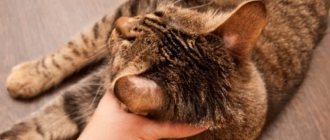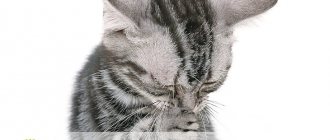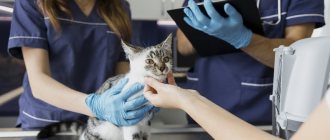Why is it developing?
Spondylosis occurs extremely rarely in kittens; it is often diagnosed in older cats. This disease is characterized by degenerative-dystrophic processes that develop as a result of aging, overload and injury to the spinal column. In addition, discopathy can also develop due to the genetic characteristics of a particular cat breed. For example, the Kurilian Bobtail has a short tail, due to which it has disturbances in the sacral spine.
These signs can trigger discospondylitis and other problems associated with intervertebral discs. If a pet has been diagnosed with rickets, the possibility of impaired disc flexibility cannot be ruled out. Subsequent growth of the kitten can cause deformation and protrusion of the fibrocartilaginous formation.
Diseases of the nervous system of cats
Diseases of the central nervous system of cats are very diverse and can be caused either by direct damage to the nervous tissue itself or as a consequence of some systemic lesions. Such as hepatitis or hormonal disorders.
Aggression
The most common and frequent symptom of many neurological diseases. A behavioral disorder that can be a completely normal condition during periods of “hunting,” pregnancy or lactation. This problem is solved by hormonal therapy or sterilization. In most cases, periods of aggression pass on their own without medical help. But the aggressiveness of cats may be a consequence of any disease, infection in particular. You should be especially wary if the cat's behavior has changed suddenly. This often speaks in favor of rabies. During this period, it is necessary to protect all family members from possible scratches and bites, and create a calm environment around the pet. If these measures do not help, you should immediately contact your veterinarian.
Types of discopathy
First type
This variety is characterized by an abrupt onset and rapid progression. This pathology is rarely diagnosed in cats. Mostly the first type of discopathy develops as a result of infectious processes that make the intervertebral discs hard and prevent healthy movements of the spinal column. During the course of discospondylitis, deformation of the layer between the vertebrae is observed; it gradually shifts and is severely destroyed. The symptoms of type 1 pathologies vary quite a bit. In some pets, only mild stiffness of movement is noticeable. Other cats move very poorly, some can be completely paralyzed.
Second type
Reduced activity and limitation in movement in older animals may be associated with the development of discopathy. It is similar to the type of discopathy described above, however, unlike it, it begins with a smooth onset. The pathology occurs gradually, so it is difficult for owners to determine its onset. Often observed in elderly pets. The early stages of development are characterized by subtle limitations of movement and decreased activity. If at this stage the disease is not identified and appropriate therapy is not carried out, the cat’s posture will be impaired.
Third type
Often this type is a consequence of serious disorders in the spinal column. The main feature of type 3 pathology lies in the lightning-fast manifestation of symptoms against the background of good health of the pet. The core of the intervertebral disc is pressed into the spinal cord, resulting in a herniation. Cats experience severe pain, which causes them to stop moving. Often there is a lack of coordination and paralysis. Often the third type of discopathy leads to death due to respiratory arrest.
Discospondylitis and its treatment
At an early stage, drug treatment is provided. Antibiotics are prescribed to which the bacteria that caused the disease are sensitive. If it is impossible to identify a pathogen on a bacterial test, broad-spectrum drugs (penicillins, fluoroquinols, etc.) are prescribed. Treatment lasts from 6 weeks to six months with periodic MRIs to monitor the progress of recovery. Painkillers and anti-inflammatory drugs (meloxicam, gabapentin, etc.) are indicated.
If a fungal infection is detected, systemic antifungal agents (fluconazole, ketaconazole) are prescribed. Glucocorticosteroids (hormones) are not used.
Surgical treatment is prescribed in advanced cases, when drug therapy is not effective or there is an urgent need to eliminate compression of the spinal cord and nerve roots. Spine surgery is mandatory for abscesses. Various techniques are used: dorsal laminectomy, hemilaminectomy, corpectomy. When instability of the spinal column develops, special structures are used.
Discopathy: what is it?
Intervertebral discs are a kind of “cushions” that consist of cartilage and fibrous tissue lying between the vertebrae. There are no intervertebral discs between the first cervical vertebrae. These “pillows” are designed to act as a lubricant and shock-absorbing element. As a result of their degeneration, the shock-absorbing function is reduced, which is fraught with the formation of hernias and compression of the spinal cord.
The term “discopathy” in veterinary medicine means a collective name for diseases characterized by changes in the intervertebral discs: displacement, prolapse into the spinal canal, compression of the spinal cord. It is these pathologies that lead to changes in the cat’s behavior, affecting its motor activity.
Many owners believe that discopathy in cats is almost a death sentence, but this is not true. The disease does not always lead to paralysis. If adequate treatment is started in a timely manner, the prognosis is favorable.
What symptoms indicate pathology?
The owner can suspect problems with the cat's spine by reducing the activity of the pet. Then symptoms such as:
- stiffness of movements;
- lameness.
Constant meowing due to pain and lameness are signs of the pathology. A cat can limp on two or one paw at once, which is directly related to the segment of damage to the spinal column. The pet begins to meow for no reason and becomes restless. Such symptoms are caused by severe pain that is localized in the back area. If the owner tries to touch it, the cat may begin to hiss and scratch. As discospondylosis progresses, the animal becomes less oriented in space and its gait changes. The possibility of a convulsive syndrome cannot be excluded. If the lumbosacral spine is affected, the emptying process is disrupted.
Symptoms
Clinical signs depend on the level of the lesion. In any case, a strong pain syndrome is observed, the animals try to be more careful, take a forced pose (hunched back, lowered head).
With compression at the level of the 5th lumbar vertebra and caudally, loss of the perineal reflex, urinary and fecal incontinence are observed. Subsequently, paresis or paralysis of the pelvic limbs occurs.
A protrusion or hernia in the cervicothoracic region is characterized by a reluctance to move the head and a gradual loss of motor function of all extremities (tetraparesis).
Diagnostic measures
When a pet owner suspects that he or she has developed spondylosis, it is important to contact a veterinarian as soon as possible. The veterinarian will conduct a survey during which he will find out how long ago the cat’s spinal problems began and what symptoms were noticed. Then the doctor begins to examine and palpate the spinal column. Next, the animal is prescribed radiography, with the help of which it is possible to see changes and distinguish discopathy from traumatic spinal injuries. An x-ray image shows the following deviations:
- destruction or narrowing of intervertebral discs;
- degree of spinal cord damage.
If required, radiography is performed with the introduction of a contrast agent.
You can find out the location of a spinal disc lesion in a cat by performing an ultrasound examination. Sometimes a cat is prescribed a magnetic resonance or computed tomography scan, but not all veterinary clinics are equipped with such expensive equipment. To confirm or refute the presence of an infectious process, a puncture of the cerebrospinal fluid is performed, which allows one to determine its composition. Bacterial culture is also required. To accurately detect the area of damage to the spinal column, ultrasound is used.
Diagnostic methods
To establish a diagnosis, an x-ray is required to show the extent of disc destruction. This most accurate diagnostic technique also allows you to distinguish discopathy from injuries and damage to the spinal column.
Necessary diagnostic methods include ultrasound and cerebrospinal fluid puncture.
Causes of spinal injuries
Typically, spinal injuries are caused by severe mechanical trauma. Much less often, the functioning of the spinal cord is disrupted by tumors, infections and hereditary defects.
The following incidents are typical for adult cats:
- falling from height;
- auto injury;
- dog bites;
- gunshot wounds.
In addition, objects that fall on top of them are dangerous for kittens: babies are playful and curious, and stick their noses everywhere. For example, the spine can easily be broken by a cutting board falling from the table.
And for kittens suffering from nutritional dystrophy (hyperparathyroidism), even minor injuries are dangerous. Their spinal fractures can be spontaneous, actually under their own weight.
Disturbances in the functioning of the spinal cord are possible even when the integrity of the spinal column is preserved, for example, with severe bruises. When the vessels of the dura mater are damaged, a hematoma occurs, which compresses the spinal cord.
How does discopathy develop in dogs?
Normally, intervertebral discs are located between all vertebrae.
Their task is to absorb vibrations and promote flexibility. With discopathy, the disc is displaced or destroyed; this also includes hernias and ruptures. The back muscles are not able to compensate for the load in chondrodystrophic breeds. Giant dogs do not always clearly demonstrate the picture of severe spinal discopathy. This is explained by the fact that their disk is much denser and larger, so it is able to maintain its integrity for a long time. The back muscles of a large animal partially compensate for disc dysfunction. With the long-term development of pathological destruction, the fibrous ring moves towards the spinal canal and disrupts the functioning of the spinal cord. As a rule, this happens suddenly and the animal, which was active just yesterday, has difficulty walking and cannot go up or down the stairs. Depending on the degree of the pathological process, the owner will observe a different picture. With significant damage without loss of basic functions of the spinal cord, the animal experiences severe pain and has difficulty supporting its limbs. In some cases, loss of motor function and complete paralysis may occur. The picture may change quickly or within a few days. Discopathy in dogs left untreated can lead to severe neurological status and impaired musculoskeletal function.
The areas of manifestation of the disease are divided into cervical and thoracolumbar localization. Cervical discopathy is characterized by a reluctance to turn the head, tremors in the neck and shoulder muscles. It accounts for no more than 15% of all identified cases. As a rule, the discs between the third and fourth vertebrae are affected. Thoracolumbar discopathy is established at the junction of the last thoracic and first lumbar vertebra.
How is the treatment carried out?
If an animal is diagnosed with discospondylitis or other spinal problems, it will need to be rested. Veterinarians recommend equipping the bed in a warm and secluded place, making it as soft as possible to reduce pain. When discopathy provokes urinary or fecal incontinence, the bed must be equipped with a waterproof diaper and constantly monitor the dryness of the material. Food and water bowls should be moved as close to the cat's resting area as possible.
Treatment is carried out with medications or surgery. If we talk about medications, then a sick pet is prescribed non-steroidal anti-inflammatory drugs and painkillers. The latter can be used before a visit to the veterinary clinic, which will improve the cat’s condition. Often they resort to the help of Papaverine with Diphenhydramine. In addition, a cat with spondylosis is prescribed sedative medications.
When the pathology has been detected in an advanced stage and conservative treatment does not bring the required therapeutic effect, the cat is prescribed surgical intervention. During the process, damaged intervertebral discs can be excised and replaced with artificial prostheses. After the operation, the cat experiences serious relief and can return to its normal lifestyle. If a pet has been paralyzed, in most situations, complete recovery of the body is not possible.
Main features
The most common is osteochondrosis of the elbow. What are the symptoms? The most characteristic sign is lameness and a slight increase in the joint capsule.
As a rule, lameness increases gradually, and the animal's condition always worsens after physical activity. The duration of development is up to a couple of years.
When the disease reaches its peak, the animal constantly holds its paw suspended, trying not to lean on it at all. If osteochondrosis affects both paws, the cat cannot walk at all.
In cases where the cat has been suffering from this disease for a long time, the muscles on the affected paw gradually begin to atrophy. They seem to “dry”, and the limb becomes thin.
The knee joint, metatarsal joints, and intervertebral disc area may also be affected. The last option is the most difficult, since in this case (with an advanced form of the disease) the cat may well remain paralyzed.
In any case, the pain with any movement will be such that the animal will probably become apathetic and refuse to eat. The cat reacts extremely aggressively to any touch on the back, as it causes pain.
This course of the disease even received its own name, “ankylosing spondylosis.”
Diseases of the spine and back: their names, symptoms and treatment
Very often, with diseases of the spine, at the initial stage they are confused with other diseases and they begin to suspect problems with the heart or other organs.
This is explained by the symptoms that accompany spinal diseases: constant fatigue, a feeling of stiffness between the shoulder blades, pain behind the sternum, numbness of the limbs, pain in the left shoulder blade, tachycardia, etc.
Contents of the article: Osteochondrosis Scoliosis Sciatica Spondylosis Herniated disc Ankylosing spondylitis
Back problems are quite common and can affect people of different age groups. However, usually no one rushes to the doctor for examination when pain in the back appears.
Most people go to the pharmacy for more painkillers and ointments. The disease progresses, which is fraught with the need for longer treatment, sometimes with surgical intervention.
There are quite a lot of different diseases of the spine.
Here is a list of the main and most common ones:
- osteochondrosis;
- scoliosis;
- sciatica;
- spondylosis;
- spondyloarthrosis;
- disc protrusion;
- intervertebral disc herniation;
- radiculopathy;
- lumbosacral radiculitis;
- spondylolisthesis;
- spondylolysis;
- cauda equina syndrome;
- myelopathy;
- spinal fractures;
- spinal tumors;
- Bekhterev's disease;
- osteoporosis;
- lordosis;
- lumbago;
- dorsopathy;
- intercostal neuralgia.
Osteochondrosis
This disease is characterized by degenerative-dystrophic changes in the tissues of the spine. This affects the intervertebral discs, vertebral bodies, adjacent articular surfaces and the ligamentous apparatus of the spine. Depending on which part of the spine the disease developed, lumbar, cervical, thoracic and mixed osteochondrosis are distinguished.
How to define a disease?
The symptoms of this disease depend on the area of the spine affected. So, with thoracic osteochondrosis, the patient will be worried about:
- attacks of pain in the ribs when walking;
- pain in the chest and between the shoulder blades, aggravated by deep inhalations and exhalations, bending over, raising arms;
- numbness of some areas of the skin;
- feeling of chest tightness;
- feeling of cold or burning in the legs.
With cervical osteochondrosis, the patient will complain of:
- frequent headaches that worsen with movement and do not disappear when taking analgesics;
- dizziness when turning the head;
- pain in the chest, arms and shoulders;
- the appearance of “floaters” before the eyes and “ringing” in the ears;
Symptoms of lumbar osteochondrosis:
- acute or constant pain in the lower back, worsening with exercise;
- pain radiating to the legs, sacrum or pelvic organs;
- a person tries to constantly be in one position in which the pain subsides.
Judging by the above symptoms of osteochondrosis, it is quite difficult to determine it yourself and you can make a mistake. Therefore, if you suspect this disease or have any of the symptoms, you should see a doctor.
In a medical institution, after passing the necessary tests and studies (MRI, ultrasound, ECG, etc.), treatment will be prescribed.
Treatment
Treatment for osteochondrosis is complex and includes medicinal and non-medicinal methods. In each case, the treatment regimen is selected individually and may include:
- Non-drug therapy:
- physiotherapy;
- manual therapy;
- traction treatment;
- therapeutic diet;
- ultrasound therapy;
- isometric kinesiotherapy;
- vibration stimulation;
- underwater hydromassage;
- laser therapy;
- magnetic stimulation.
- Drug therapy:
- NSAIDs in the form of tablets, injections, ointments and gels (Diclofenac, Olfen, Movalis, Ketanov, Ibuprofen, Ortofen, Naklofen, Indomethacin, etc.);
- antispasmodics (No-shpa, Miolastan, Sirdalut, etc.);
- antioxidants (vitamin C, tocopherol, mexidol, etc.);
- blood microcirculation stimulants (Trental, Actovegin, Teonicol, nicotinic acid, etc.);
- chondroprotectors (Glucosamine sulfate, Chondroitin sulfate, Alflutop, Rumalon, etc.)
Scoliosis
This disease is defined as a persistent lateral curvature of the spine, which causes disturbances in the internal organs, causes pain, and decreases the mobility of the spine. The development of this disease is most typical between the ages of 6 and 15 years.
How to define a disease?
It is very important to pay attention to the child’s poor posture in time in order to begin treatment and not start the disease. Since the disease appears in childhood, its presence can be suspected when a child complains of pain in the chest, legs, pelvis, or constant fatigue. You can visually determine stoop. In advanced cases, the child begins to walk sideways or limp.
If you have any suspicions, you should immediately contact a doctor to prevent the disease from progressing. The doctor will conduct an orthopedic examination, assess the neurological status and metabolic processes of the patient and prescribe effective treatment.
Treatment
Treatment of scoliosis includes a whole range of measures, including:
- physiotherapy;
- manual therapy;
- wearing special corsets;
- classes on special simulators;
- drug therapy if necessary to relieve pain, as well as with concomitant metabolic or nervous disorders.
Sciatica
This disease usually manifests itself with exacerbations 2-3 times a year and is defined as inflammation of the sciatic nerve.
How to define a disease?
Sciatica is a disease with very varied and not constant symptoms. It may present differently in different patients.
The main symptom is pain, which can be localized in the lower back, or can spread to the buttock and cover the entire leg, down to the toes. At the same time, it is characterized as:
- sharp shooting;
- burning, goosebumps, numbness;
- becomes stronger over time.
In advanced cases, the pain becomes unbearable and appears in attacks with any movement, and sometimes even while standing still.
The doctor examines the patient. If necessary, computed tomography, electromyography, fluoroscopy and MRI may be prescribed.
Treatment
Treatment of sciatica should be comprehensive. It depends on the patient’s condition and the characteristics of the disease. May be assigned:
- manual therapy;
- physiotherapy;
- acupressure;
- vacuum therapy;
- surgical intervention;
- taking painkillers from the NSAID group (Diclofenac, Meloxicam, Ketanov, Ortofen, Ibuprofen, Indomethacin, etc.);
- novocaine blockades.
Spondylosis
The disease occurs due to degenerative changes in the spine, in which bone tissue grows along the edges of the vertebrae.
Depending on the location of development, spondylosis is divided into thoracic, cervical and lumbar. At the same time, thoracic spondylosis is least manifested by symptoms, which is why patients are not aware of it for a long time.
How to define a disease?
The main symptom of the disease is pain and limited mobility at the site of degenerative changes. In addition, the pain intensifies at night and spreads to the entire spine. It is difficult for the patient to find a body position in which the pain is less pronounced.
Since the symptoms are also typical for other back diseases, you should consult a doctor for a diagnosis. To clarify the diagnosis, an X-ray examination, computed tomography or MRI will be required.
Treatment
Treatment of spondylosis is complex and is aimed at preserving the process of bone tissue growth and reducing symptoms.
Can be used:
- massage;
- acupuncture;
- soft osteopathic techniques;
- hirudotherapy;
- electrophoresis;
- shock wave therapy;
- physiotherapy;
- taking NSAIDs (Ibuprofen, Ortofen, Movalis, Ketanov, Diclofenac, etc.).
Disc protrusion
This disease is the initial stage of disc herniation, which is manifested by protrusion of the intervertebral disc without rupture of the fibrous ring.
Most often, protrusion occurs in the lumbar spine.
Herniated disc
How to define a disease?
Symptoms of the disease depend on the location of the protrusion. Below are the main ones that should prompt you to consult a doctor for a diagnosis and treatment:
- pain that occurs at the site of protrusion and intensifies with movements, prolonged stay in one position, it can spread to the head, arm or legs;
- thoracalgia;
- muscle weakness;
- numbness;
- limited mobility.
Treatment
Treatment of protrusion, like other diseases of the spine, is carried out comprehensively and includes several techniques to obtain a lasting result:
- laser therapy;
- physiotherapy;
- acupuncture;
- pharmacopuncture;
- vacuum therapy;
- taking NSAIDs (Diclofenac, Ortofen, Ibutard, Ketanov, Movalis, etc.);
- taking B vitamins;
- taking muscle relaxants.
Radiculopathy
Radiculopathy combines conditions associated with a disease of the peripheral nervous system that occurs due to pinching, damage or inflammation of the spinal nerve roots. Most often, radiculitis develops against the background of osteochondrosis or other back diseases.
How to define a disease?
Symptoms of the disease are quite different and depend on the location of the root damage. Conventionally, they can be combined into 3 groups:
- The pain can be of varying intensity and severity, constant or periodic, localized or radiating to the limbs and other parts of the spine.
- The occurrence of numbness, tingling, burning in the extremities due to impaired sensitivity.
- Muscle weakness.
If you have any of these symptoms, you should consult a doctor. Since at home it is impossible to differentiate back diseases on your own, and self-medication is generally not recommended!
Treatment
Radiculitis must be treated comprehensively. Can be used:
- physiotherapy;
- manual therapy;
- traction;
- taking NSAIDs (Naproxen, Ibuprofen, Diclofenac, Dexalgin, Nimesulide, Piroxicam, Meloxicam, etc.)
- taking muscle relaxants (Sirdalut, Mydocalm, etc.)
- If the cause of the development of radiculitis is stress, then antidepressants and sedatives are additionally prescribed.
Ankylosing spondylitis
This disease is also called ankylosing spondylitis. It manifests itself as a systemic chronic disease of the joints, in which the pathological process is localized mainly in the paravertebral soft tissues, sacroiliac joints and spinal joints.
How to define a disease?
You can suspect that you have this disease if you have the following symptoms:
- weakness, increased fatigue;
- soreness of all muscles and joints;
- eye lesions;
- pain and feeling of stiffness in the lower back, intensifying in the morning;
- pathological kyphosis;
In the later stages of the disease, fusion of the vertebral joints and the formation of intervertebral bone bridges are noted.
To make a diagnosis, in addition to examination and tests, the doctor may prescribe an MRI, computed tomography or x-ray examination of the spine. Additionally, an analysis is prescribed to identify a specific antigen.
Unfortunately, this disease is not completely curable, but if you consult a doctor in a timely manner and follow treatment, you can slow down the progression and alleviate the general condition.











